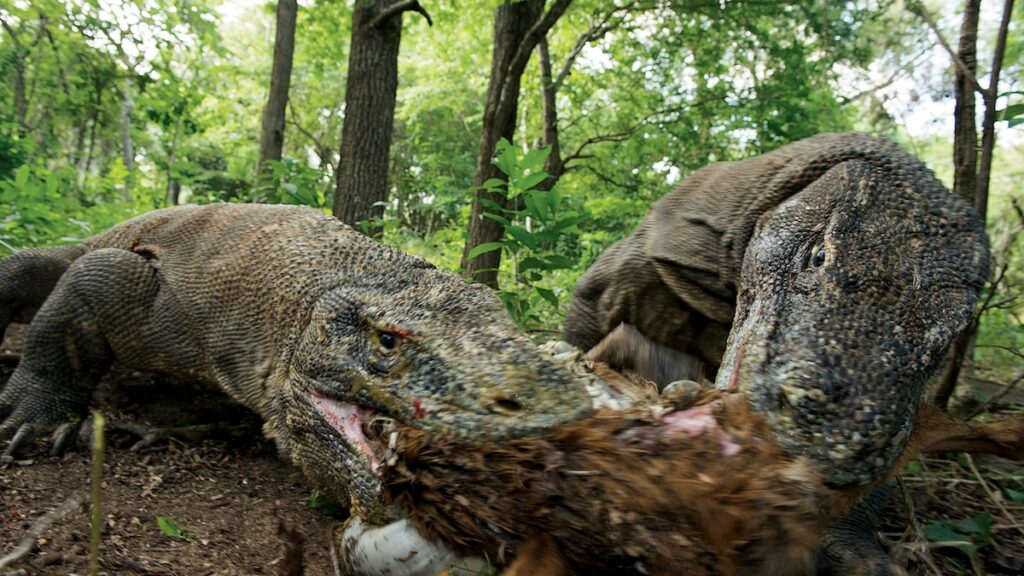The teeth of the Komodo dragon are a sight to behold. Triangular, curved, and armed with a serrated edge similar to a steak knife, they are perfectly adapted to cut into the flesh of their prey.
Now, a new study has uncovered another marvel of dragon teeth: they’re coated in iron.
The world’s largest reptile, the Komodo dragon is an endangered carnivore native to Indonesia. Paleontologists are particularly interested in dragon teeth because of their similarities with dinosaurs, which may provide insights into tooth evolution.
“We’ve never seen iron in reptile teeth, which is very interesting,” says study co-author Domenic D’Amore, a paleontologist at Daemen University in New York.
A close-up image of a Komodo dragon tooth shows orange-tinged iron on its cutting edge.
Photograph By Aaron LeBlanc
Gnawing mammals such beavers, rats, and shrews sport the metal in their teeth, which toughens their bite. But scientists have long believed reptile teeth didn’t have special adaptations to keep their weaponry sharp. Unlike mammals, reptiles shed and grow new teeth throughout their lives, and so can dispose of any teeth that have been worn down. Komodos also have a venomous bite, which stuns their prey before they tear it apart with sharp teeth and claws. (Learn why komodo dragons stick close to home.)
The new research, therefore, opens up a series of questions. Does iron also exist in the teeth of other reptiles? What about ancient reptilians like dinosaurs? What other tooth adaptations exist?
“[The study] tells us that reptiles still hold a lot of surprises,” says study leader Aaron LeBlanc, a paleontologist at King’s College London. “It’s leading down a whole new avenue of research.”
The iron-enhanced teeth allow Komodo dragons to more easily tear their prey apart.
Photograph By Aaron LeBlanc
An orange-tinted mystery
LeBlanc didn’t set out to research Komodo dragons. He was interested in the gnashers of meat-eating dinosaurs. But it’s a challenging subject.
“When a dinosaur tooth has been buried underground for millions of years, it undergoes a lot of changes chemically as well as mechanically,” LeBlanc says, “so it’s really hard to get anything meaningful out of it.”
The komodo, on the other hand, is an analog to dinosaurs, which means it’s an animal still living today that shares traits—such as long, curved, jagged teeth—with extinct animals.
As LeBlanc started inspecting Komodo dragon teeth from museum specimens, he noticed a pattern: an orange tinge along the serrated edges.
“I probably saw it three or four times, and completely dismissed it, thinking that this was staining from feeding,” he says; the reptiles take up iron from their meat-rich diets. As he saw more, he began to enlist the help from other scientists and museum curators to inspect dragon skulls. The pattern, it turns out, was consistent across the specimens. (Learn where you can see komodo dragons in the wild.)
By cutting up teeth and subjecting them to further chemical analyses, LeBlanc and his colleagues found that the orange on these reptile teeth was, indeed, iron.
Using high-powered microscopes, the researchers could then see the iron within a thin layer of the enamel. “We saw it’s actually a coating on top of the enamel, sort of like icing on the top of the cake,” says LeBlanc.
“It’s interesting that the serrations have the majority of the iron, which suggests that they’re reinforced. Because they’re particularly important” for shearing apart prey, D’Amore says.
Toothy adaptations
The study authors also inspected the teeth of other monitor lizards, crocodilians—the group that includes crocodiles, gharials, caimans, and alligators—as well as some fossilized dinosaur teeth. These animals had trace amounts of iron in their teeth.
For the dinosaurs, it’s possible the fossilization process introduced the metal into their bones. More intriguing, though, is that the dinosaurs’ teeth had thick, wavy enamel, the team says.
Animals also reinforce their teeth by evolving new structures of enamel—one of the two tissues, along with dentin, that are present in all animal teeth.
For instance, mammals tend to have thicker enamel than reptiles, and the enamel can form cusps on teeth to be better suited for different diets.
“So maybe [dinosaurs] don’t need the iron because they have this different type of enamel,” says Kirstin Brink, a paleontologist at the University of Manitoba who wasn’t involved in the new study. “They’ve kind of figured out another way to strengthen their teeth.”
D’Amore agrees that from an evolutionary standpoint, reptiles seem to be taking on many diverse strategies with their teeth.
“Clearly, Komodo dragons are sort of just the beginning of us trying to understand that, but I’m sure we’ll see other things out there too that we just don’t expect yet.”
>>> Read full article>>>
Copyright for syndicated content belongs to the linked Source : National Geographic – https://www.nationalgeographic.com/animals/article/komodo-dragons-iron-teeth-predators
